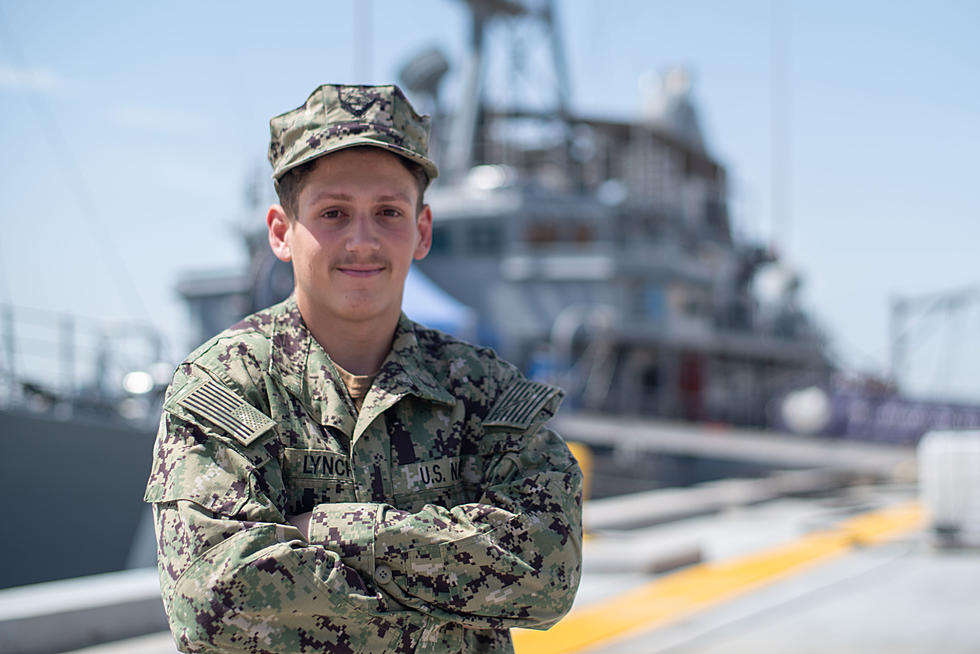
Temple Native Austin Lynch Serves as Fireman Aboard Naval Mine Detection and Dispoal Ship
The lessons I learned from my hometown is to always be on time, and to treat everybody with the utmost respect.
By Chief Mass Communication Specialist Erica R. Gardner, Navy Office of Community Outreach
Photo by Mass Communication Specialist 2nd Class Jackson Brown
NAVAL SUPPORT ACTIVITY BAHRAIN – Fireman Austin Lynch, a Temple, Texas, native credits his father as his inspiration for joining the Navy.
“I saw how happy he was when he got out, and the benefits he earned,” said Lynch.
Now, one years later and half a world away at Naval Support Activity Bahrain, Lynch serves aboard an avenger-class mine countermeasures ship (MCM), USS Devastator, tasked to search and dispose of enemy mines in the world’s most dynamic maritime region as the leading-edge of the Navy.
“We have to perform a lot of maintenance,” said Lynch. “There is a lot of responsibility.”
Lynch, a 2018 graduate of Belton High School, is a fireman aboard the Manama, Bahrain-based ship, one of four MCMs forward-deployed to the Arabian Gulf in the Navy’s U.S. 5th Fleet operating under Task Force 52.
“There is a lot of advanced electrical equipment on mine countermeasure ships,” said Lynch. “If something goes wrong I have to fix it, and that can be highly dangerous because of the high voltage.”
Task Force 52 plans and executes mine warfare operations in support of U.S. 5th Fleet’s operational objectives.
Lynch credits success in the MCM force, and in the Navy, to many of the lessons learned in Temple.
“The lessons I learned from my hometown is to always be on time, and to treat everybody with the utmost respect,” said Lynch.
USS Devastator is 224 feet long, 39 feet wide and weighs over 1,300 tons. Four diesel engines, designed to have very low magnetic and acoustic signatures, help push the ship through the water at 16 miles per hour.
As mines threaten maritime traffic indiscriminately, the U.S. and partner nations are committed to taking all action necessary to reduce the risk of mines to support the continuous free flow of commerce and freedom of navigation throughout the region.
Serving in the Navy means the world to me because of all that I have been able to accomplish for myself and my family.
MCMs are outfitted with the means to detect and disable them, ensuring sea lanes remain open for military, commercial and civilian vessels. These ships use a variety of novel and conventional sweeping measures, including sonar and video systems, cable cutters and remote control mine-detonating devices.
“Without any electricity the switchboard does not work and the ship does not run ,” said Lynch.
The Navy’s mine countermeasures in the U.S. 5th Fleet are divided between three separate legs, consisting of airborne, surface and underwater methods. These consist of the MCMs such as USS Devastator, MH-53E Sea Dragon helicopters from Helicopter Mine Countermeasures Squadron (HM) 15, and unmanned underwater vehicles, as well as expeditionary explosive ordnance disposal teams. All three legs work together to hunt and neutralize mines.
The Navy’s U.S. 5th Fleet area of operations encompasses about 2.5 million square miles of ocean, and includes the Arabian Gulf, Gulf of Oman, Red Sea and parts of the Indian Ocean. This expanse, comprised of 20 countries, includes three critical choke points; the Strait of Hormuz, the Suez Canal and the Strait of Bab al Mandeb at the southern tip of Yemen.
“I’m incredibly proud to serve with each of our Sailors, Coastguardsmen and Marines forward-deployed to the U.S. 5th Fleet area of operations,” said Rear Admiral Paul Schlise, deputy commander for NAVCENT/ U.S. 5th Fleet. “They represent the very best of our country and serve as volunteers in a complex and dynamic region that’s vital to our security. I am honored to work alongside these warriors.”
“This is my first duty station and I am in a part of a world I have never seen before,” said Lynch. “There are many cultures and foods to experience.”
Serving in the Navy means Lynch is part of a world that is taking on new importance in America’s focus on rebuilding military readiness, strengthening alliances and reforming business practices in support of the National Defense Strategy.
A key element of the Navy the nation needs is tied to the fact that America is a maritime nation, and that the nation’s prosperity is tied to the ability to operate freely on the world’s oceans. More than 70 percent of the Earth’s surface is covered by water; 80 percent of the world’s population lives close to a coast; and 90 percent of all global trade by volume travels by sea.
“Our priorities center on people, capabilities and processes, and will be achieved by our focus on speed, value, results and partnerships,” said Secretary of the Navy Richard V. Spencer. “Readiness, lethality and modernization are the requirements driving these priorities.”
Though there are many ways for sailors to earn distinction in their command, community, and career, Lynch is most proud of continuing to learn and earn qualifications.
“Being highly qualified means I know what I am talking about,” said Lynch. “This also shows my shipmates that I am qualified for the job I am doing.”
As a member of one of the U.S. Navy’s most relied upon assets, Lynch and other sailors know they are part of a legacy that will last beyond their lifetimes contributing to the Navy the nation needs
“Serving in the Navy means the world to me because of all that I have been able to accomplish for myself and my family,” said Lynch.

